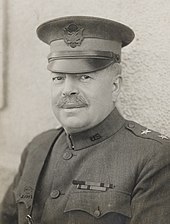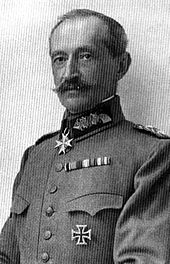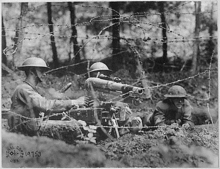Battle of Château-Thierry
| date | July 15-17, 1918 |
|---|---|
| place | Château-Thierry |
| output | German withdrawal |
| consequences | End of the spring offensive |
| Parties to the conflict | |
|---|---|
| Commander | |
| losses | |
|
unknown |
unknown |
The struggles of Château-Thierry , from 15 to 21 July 1918 were in the First World War, part of the Second Battle of the Marne . This conflict between troops of the German Empire and US-French soldiers on the central western front ended with the withdrawal of the Germans. In the successful defense of the German attacks on both sides of Château-Thierry (July 15/16), the 3rd Division of the American Expeditionary Force (AEF) stood out and earned the nickname "Rock of the Marne" for it. The actually decisive battle of Soissons (July 18-22, 1918) took place 20 kilometers to the north-west, but was directly related to the fighting at Château-Thierry.
prehistory
To larger fighting in the Château-Thierry (as after the First Battle of the Marne in 1914), there was already on June 1, 1918, when in the course of the oncoming on May 27 Battle of the Aisne , German troops ( 231st Division under Major General Bernhard von Pods ) reached the place. Then troops of the American Expeditionary Forces under General John Pershing were sent to the French to protect their threatened capital, Paris . The 3rd Infantry Division under Major General Joseph T. Dickman was marched on May 31st to reinforce the French lines to Château-Thierry. The 2nd Infantry Division under Major General Omar Bundy was supposed to close the road from Paris to Metz .
In the days up to June 4th, units of the 3rd Division such as the 7th Motorized Machine Gun Battalion succeeded in thwarting German attempts to cross the Marne at Château-Thierry . West of the city, the 2nd Division, to which units of the United States Marine Corps were subordinate, attacked the Bois de Belleau , held by the Germans , here the battle developed in the Belleau Forest . The German troops stood from Château-Thierry in the west to Dormans in the east on the Marne, only 60 kilometers from Paris , but were unable to establish a permanent bridgehead on the southern bank during this phase of the attack.
Preparations
On the right wing of the French 6th Army under General Jean-Marie Degoutte at the beginning of July 1918, the 3rd Division (Major General Joseph T. Dickman) and the 28th Division (Major General Charles H. Muir ) of the American units were in Position. The 3rd US Division, the French XXXVIII. Corps of General Jean de Mondésir , held a 12 kilometer wide front along the Marne that stretched from the outskirts of Château-Thierry in the west to the slopes of the Surmelin Valley to the east. The north-facing front of Infantry Regiments No. 4, 7, 30, and 38 were all oriented from west to east. To the right of the 3rd Division was the French III. Corps (General Léonce Lebrun ) with the 125th Division (General Antoine Diebold), which had been reinforced by the American 55th Infantry Brigade of the 28th US Division. While the majority of the brigade in the second line of the 125th Division, about three and a half kilometers further back, occupied a six-kilometer front, four companies of the 109th and 110th Infantry Regiments took up positions on the south bank of the Marne.
The wooded, hilly slopes and overgrown fields on the southern bank of the Marne were ideal defensive terrain, offering the Americans both disguise and cover. General de Mondésir instructed General Dickman to prepare a rigid front defense instead of the defense in depth. General Dickman gave his soldiers the freedom to prepare their defenses at their own discretion. Along the entire front of the 3rd US Division, the front line on the bank of the river consisted of widely spaced trenches and machine gun nests. Behind it were the entrenchments parallel to the Marne as a second defense position. This included shallow trenches and shelters that served as command posts or accommodation. The third and final position of defense was through the Bois d'Aigremont to the south. Colonel Edmund L. Butts, in command of the 30th Infantry Regiment, distributed his battalions to the widely spaced positions of the first, second and third lines and prepared an effective defense in depth. Colonel Ulysses G. McAlexander , however , ordered his 38th Infantry Regiment to reinforce the front line and positioned four companies there - about 1,000 men - to prevent the Germans from crossing the river. He divided the rest of the regiment on a second line between 2,700 and 5,400 meters from the Marne. passed.
Colonel McAlexander, suspecting the French to his right would retreat early if the Germans attempted to use Surmelin Valley cover to infiltrate his sector, took precautionary measures by digging additional trenches throughout Position of the 38th Infantry Regiment to the east. The Americans within the French 125th Division found defensive preparations in their sector even more confusing. Companies L and M of the 109th Infantry Regiment and Companies B and C of the 110th Infantry kept full trenches along the railroad and near the northern edges of the Bois de Condé, no more than a few hundred meters from the Marne. If no other instructions came, the four companies stationed on the river wanted to defend there as well.
On the opposite side of the Marne, the troops prepared the German XXIII. General von Kathen's reserve corps - the westernmost formation of the 7th Army - on the river crossing. The German 10th Division was on the left wing throughout the entire Marneschutz offensive. Infantry Regiment No. 398 and Grenadier Regiment No. 6 were ordered to cross the Marne and advance through the sector of the American 30th Infantry Regiment. Immediately to the east was the German 36th Division , which was to attack with the 5th Grenadier and Infantry Regiment No. 128 along the front of the French 125th Division and the American 38th Infantry Regiment. The task of the XXIII. Reserve Corps consisted of crossing the Marne on a 6-kilometer-wide front, with the advance limited to two kilometers on the first day. Once in this position, the Kathen group were ordered to dig in and await the fall of Reims.
The battles of Château-Thierry

On July 15, the attack by 17 divisions of the German 7th Army against the French 5th and 6th Armies began in the area west of Reims . The right wing ( Schoeler group with 87th and 201st divisions ) had to cover the attack to the west, the center ( Kathen and Wichura group ) was to cover five divisions (10th, 36th, 23rd Saxon , 200th and 1st division) Guard Division ) cross the Marne section Chartèves - Verneuil . The Conta group (37th, 113th and 10th reserve divisions) had to win the Surmelin Bach at Dormans . The 37th and 113th Divisions had to attack south of the Marne and the 2nd Guard Division to advance north of the river on Epernay . The left wing of the 7th Army ( Schmettow Group ) was to attack with the 103rd, 22nd , 195th and 123rd Divisions north of the Marne via the Montagne de Reims and win the Ay - Nanteuil - Bligny line .
At 2:10 a.m., parts of the Kathen group's left wing had fought for the south bank of the Marne. On the right wing, the 10th Landwehr Division (Lieutenant General von Werder ) had orders to remain defensive in the section at Mont-Saint-Père and Gland and to cover only the right wing of the 10th Division (Major General von Diepenbroick-Grüter ) . Dickman's division threw the German enemy (parts of the 36th division ) back over the river at Mézy-Moulins and retook the southern part of Crézancy . At 12.45, General de Mondésir also took additional steps to replace the position of his XXXVIII. Corps and ordered the French 73rd Division to advance into the gap that had opened between the American and French units east of the Surmelin. The attack began at 7.30 p.m. and led to the capture of the court of Les Étangs, about two kilometers east of the Surmelin Valley.
On the morning of July 18, at 4.45 a.m., the French 10th and left wings of the 6th Army, with their assigned American divisions (1st, 2nd, and 4th), crossed the front line between Fontenoy and the Ourcq sector of about 40 km to counterattack. On the Marne, the right wing of the French 6th Army remained in defense that day, while to the east of it the 9th Army (General Antoine de Mitry ) began the major attack in the area south of Dorman against the six German divisions located in the southern Marne bridgehead. The 26th US Division (Major General Clarence R. Edwards ) was located northwest of Chateau-Thierry and together with the French 167th Division formed the right wing of the I Corps (Major General Hunter Liggett ), which after the displacement of the French XXXVIII . Corps to the newly formed 9th Army had taken over tactical leadership. The French 39th Division was not able to fully occupy Château-Thierry, which was defended by the Germans, until July 21 at 8:00 a.m.
In the subsequent recapture of the Marne front arc, a total of around 250,000 US soldiers with 9 divisions and 2 corps commands ( I Corps and III Corps ) were involved by the end of July . The positions of the German group Schmettow ( Gen. Kdo. 65 ) and Borne ( Gen. Kdo. VI. Res. K. ) on the eastern front in the Marnebogen had to be withdrawn against the French 5th Army (General Berthelot).
aftermath
German historiography took hardly any notice of the battles at Château-Thierry, but the battles play a special role in American historiography. On the one hand it was the furthest advance of the German armed forces on Paris in the German spring offensive in 1918 , on the other hand it was the first effective intervention of closed American divisions in the First World War. The first battle of Chateau-Thierry on June 1 was the first time since the American Revolutionary War that American and French troops fought side by side under the same command. Many American patriots see the intervention of the American Expeditionary Forces in the acts of war as a turning point in the war. As a result, the American memorial Château-Thierry was inaugurated there after the war .
The German Infantry Regiment No. 401 of the 201st Division (Lieutenant General Bachelin ) was involved in the battle for height 204. When the American Battle Monuments Commission was planning the American memorial at Château-Thierry on October 9, 1929 , the war diary of the 401st Regiment was sent to Washington for evaluation for the period in question . With the destruction of the Reich Archives on April 14, 1945, all war diaries of the German regiments of the First World War were lost. Therefore, the remaining copies allow valuable conclusions to be drawn about the basic and schematic structure of a war diary of that time.
literature
- George W. Browne: Divisional records of the American expeditionary forces in Europe, compiled from official sources by GW Browne and Rosecrans W. Pillsbury, Overseas Book Company 121, 19211851-1930.
- The battles and skirmishes of the Great War 1914–1918 . Great General Staff, Berlin 1919
- Commons : Diary IR 401 - Collection of Images, Videos, and Audio Files











